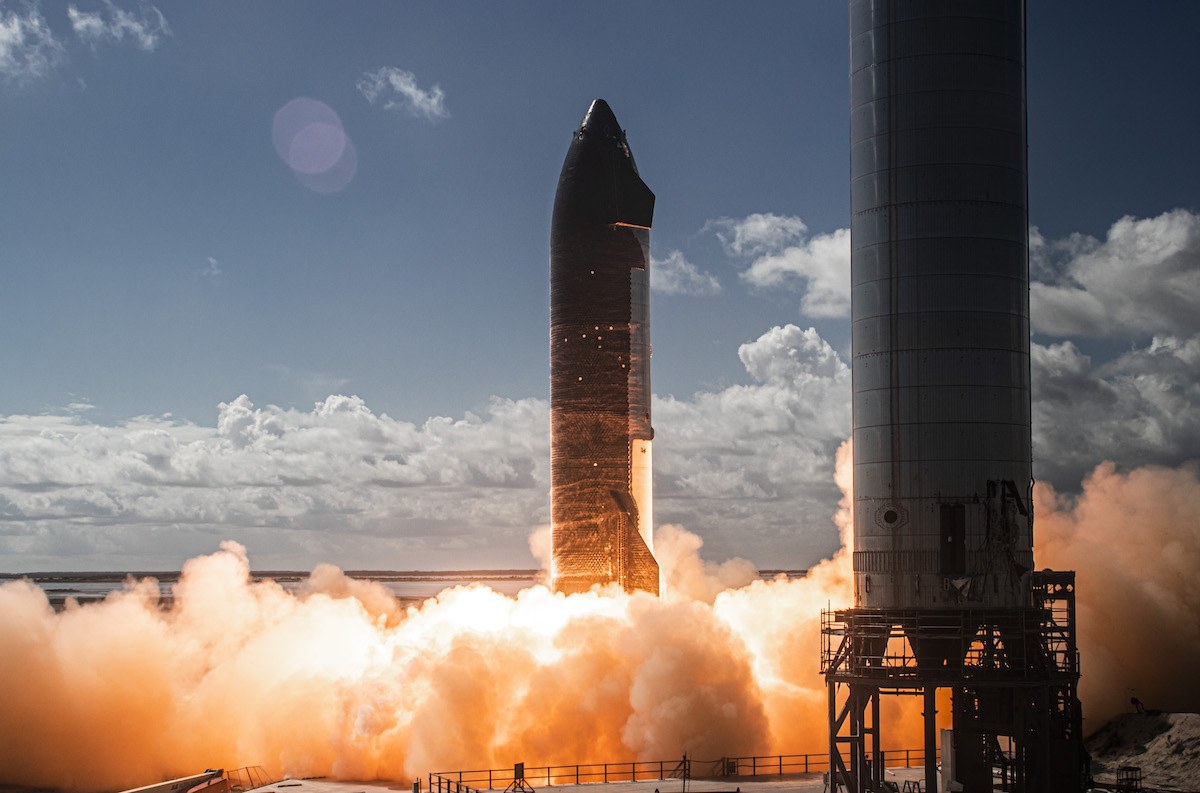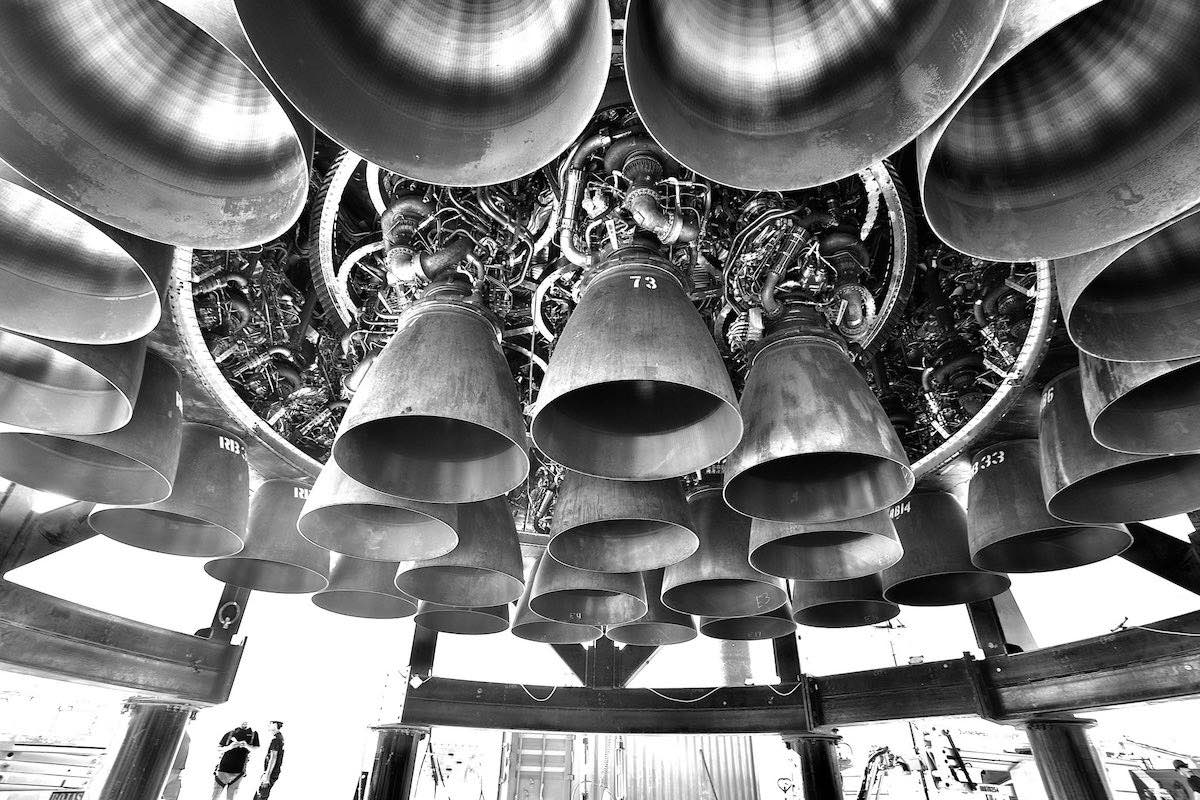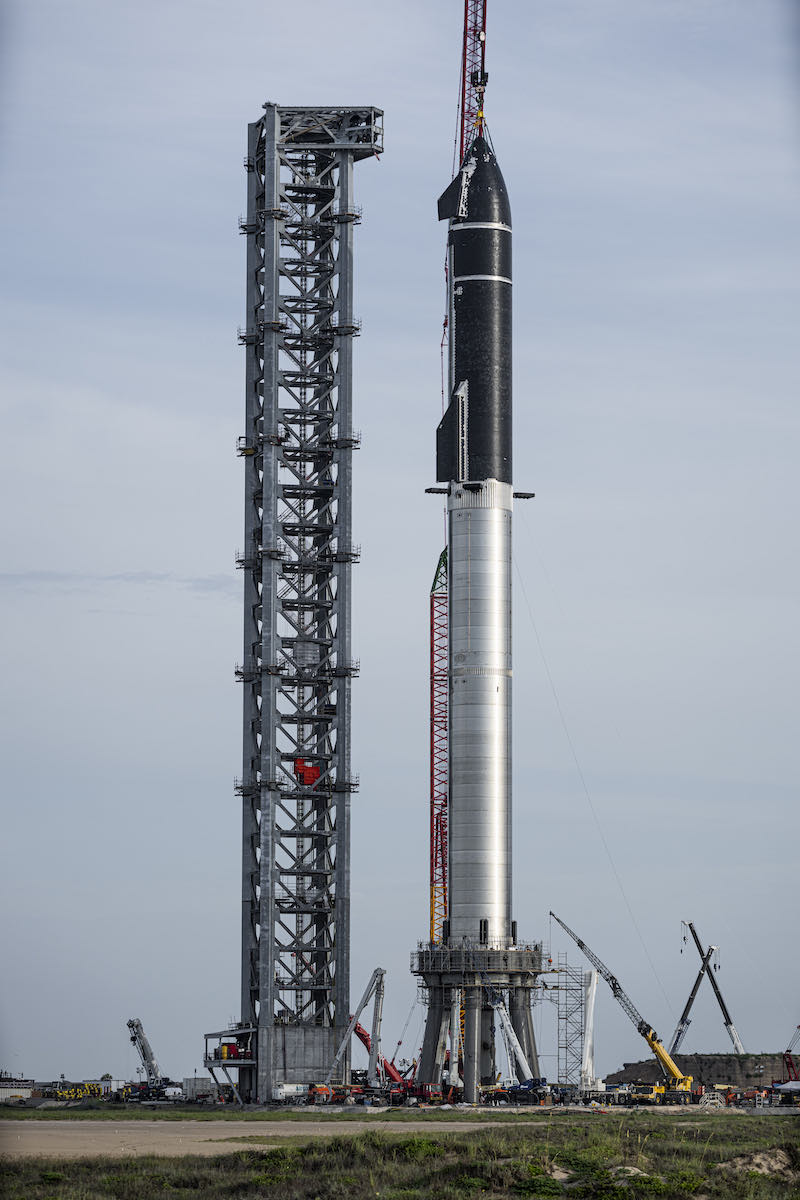
SpaceX’s team in South Texas is gearing up to be ready for the first combined launch of the Super Heavy booster and Starship mega-rocket as soon as January, assuming the company completes launch pad construction, ground testing, and secures regulatory approval from the Federal Aviation Administration, founder Elon Musk said Wednesday.
The new schedule rules out a launch before the end of the year. A delay into 2022 was widely expected as SpaceX awaits the completion of an environmental review from the FAA, and races to finish assembly of a launch pad tower to support the nearly 400-foot-tall (120-meter) rocket.
“We’re expecting our license approval from the FAA around the end of this year, and so that probably means a launch attempt in January, or perhaps February,” Musk said in a discussion with the Space Studies Board and the Board on Physics and Astronomy, part of the National Academies Sciences, Engineering, and Medicine.
As he did before the debut of SpaceX’s Falcon 9 and Falcon Heavy rockets, Musk tried to manage expectations on the outcome of the first Starship orbital launch attempt.
“We’ve completed the first orbital booster and first orbital ship, and we’ll be complete with the launch pad and launch tower later this month, and then we’ll do a bunch of tests in December, and hopefully launch in January,” Musk said.
“There’s a lot of risk associated with this first launch, so I would not say it is likely to be successful, but I think we’ll make a lot of progress,” musk said. “We’ve also built a factory for making a lot of these vehicles. So this is not a case for just one or two. We’re aiming to make a great many.
“We intend to do hopefully a dozen launches next year, maybe more,” Musk said. “And if we’re successful with it being fully reusable, that means we build up the fleet just as we are with the Falcon 9 booster, which is reused.”
Musk says the cost of a Starship launch will eventually fall below the cost of a Falcon 9 rocket flight, which a SpaceX manager said last year can fall below $30 million with reused parts.
“Basically, we intend to complete the test flight program next year, which means it’s probably ready for valuable payloads that are not for testing, but actual real payloads, in 2023.”
The FAA said Monday that it has a target date of Dec. 31 to complete an environmental assessment of SpaceX’s operations at Boca Chica Beach, a location on the Gulf Coast of Texas east of Brownsville. The review is a prerequisite for the FAA to issue a commercial launch license for the Starship orbital test flight.

The FAA issued a draft environmental report in September after consultation with several federal and state agencies, then held two hearings in October to obtain public comments.
The draft report marks a re-evaluation of the FAA’s original environmental impact statement before SpaceX started construction of the Boca Chica site in 2014. At that time, SpaceX planned to launch Falcon 9 and Falcon Heavy rockets from South Texas, but the scope of the project has since changed to focus on development of the much larger Starship and Super Heavy.
Assuming the FAA concludes that Starship operations will not have a significant environmental impact, or that any effects can be mitigated, regulators will give the green light for the orbital test flight. Otherwise, the FAA will begin work on a new environmental impact statement, which would likely take months, or perhaps even years.
While SpaceX waits for FAA approval, engineers have continued to make technical progress toward the Starship orbital test flight. Workers have installed heat shield tiles on the Starship vehicle, and test-fired the rocket’s six Raptor engines for the first time Nov. 12.
A similar static fire test of the 29 Raptor engines on the Super Heavy booster could happen before the end of the year.
“What we’re aiming to develop with Starship is a generalized means of transporting large amounts of mass, or people … anywhere in the solar system,” Musk said Wednesday, repeating his goal for the Starship program. “The idea behind this is to have the first fully and rapidly reusable rocket. That’s really the holy grail of rocketry. If you can have a fully and rapidly reusable … orbital rocket, then the cost of transport to orbit drops by about two orders of magnitude, maybe better.”
The Starship architecture consists of a Super Heavy booster and the Starship vehicle, which serves initially as an upper stage during a launch into Earth orbit, then as a space transporter, and finally as an Earth return vehicle for payloads and people.
SpaceX has established an ever-growing factory down the road from the launch and landing complex near the beach. The company assembled a series of sub-scale and full-size Starship prototypes since 2019, and launched five high-altitude atmospheric test flights from December 2020 through May of this year.
The fifth high-altitude flight May 5 was the first to nail its vertical, rocket-assisted landing back on the ground at Boca Chica. The other Starships landed hard, exploding on touchdown, or in one case, a few minutes later.
The Starship’s atmospheric test flight phase is over, and Musk is directing the team in Texas to prepare for the first orbital test flight of the full Super Heavy and Starship stack.

SpaceX is developing the Starship vehicle as a fully reusable launch and space transportation system capable of ferrying more than 100 metric tons of cargo into low Earth orbit, more than any other rocket in the world. SpaceX eventually aims to develop an in-space refueling capability to extend Starship’s heavy-duty cargo carrying range into the solar system.
“I think it is a very profound vehicle,” Musk said of the Starship. “I don’t think anything like it is being developed, and I don’t think anything quite like it has even been proposed, but it has the potential to affect human destiny in a very good way.”
SpaceX’s corporate mission is to make human life multi-planetary, and Musk argues that a fully reusable launcher and transporter of the scale of Starship is needed to make that vision a reality.
NASA is the first major customer for SpaceX’s Starship program. The space agency announced a $2.9 billion contract in April for SpaceX to develop a human-rated moon lander derived from the Starship for Artemis lunar missions.
Blue Origin, a rival space company founded by billionaire Jeff Bezos, also bid on the lunar lander contract. Blue Origin sued NASA protesting the award to SpaceX, but a federal judge dismissed the lawsuit earlier this month.
“We’re not assuming any international collaboration. We’re building this thing right now. We’re really building it from internal funds,” Musk said. “NASA is providing some support because they intend to use Starship for transporting astronauts to the surface of the moon, but this has been an internally funded effort — probably at least 90% internally funded so far.”
Musk said SpaceX is working with Saul Perlmutter, an astrophysicist at Lawrence Berkeley National Laboratory, on “really big” space-based telescope project that could launch on Starship. Aside from its heavy-lift capacity, the rocket’s nearly 30-foot (9-meter) diameter is wider than a Boeing 747 jumbo jet, giving Starship a larger payload volume than any other existing launch vehicle.
“This is taking a ground-based lens, or a lens that was intended for a ground-based telescope, and creating a space-based telescope with it,” Musk said. “So that could be, I think, pretty interesting, and we’d love to do other things as well.
“The great thing about Starship is it really should enable us to send very big things, and also to send them fast,” Musk said. “We need much less in the way of planetary gravity assists and that kind of thing,”
Musk said that long-term development of propellant generation plants on the moon and Mars would enable trips to asteroids, the moons of Jupiter, and other distant destinations.
“Basically, any place we can put the gas station that goes another whole leap forward,” he said.
During an orbital launch attempt, a reusable Super Heavy first stage booster will detach from the Starship and come back to Earth for a vertical landing, returning directly to the same pad where it launched. For the first orbital mission, SpaceX plans an expendable flight profile, with the booster heading to a water landing in the Gulf of Mexico.
The Starship will continue into orbit and deploy its payloads or travel to its deep space destination, and finally return to Earth to be flown again. The Starship vehicle doubles as an upper stage and a refillable transporter to ferry people and cargo through space to destinations in Earth orbit, the moon, Mars, and other distant locations.
The reusable architecture, which builds upon SpaceX’s partially reusable Falcon 9 rocket, is designed to reduce the cost of each flight.
The Starship’s first orbital test flight, though unmatched in scale, will aim to prove out the rocket’s basic launch and re-entry capabilities without fully testing out the complicated landing and recovery systems, according to a SpaceX’s filing with the Federal Communications Commission earlier this year.
On the first orbital mission, SpaceX plans for the Starship to re-enter the atmosphere after one trip around Earth. Shielded by thermal protection tiles, the vehicle will head for a controlled landing at sea in the Pacific Ocean near Hawaii.
SpaceX is also modifying offshore oil drilling rigs to serve as floating Starship launch and landing platforms, and plans to build a Starship launch complex at Kennedy Space Center in Florida.
“We’re actually building the factory to make lots of Starships and make lots of engines in parallel, so there will be many, many vehicles,” Musk said.
He said that SpaceX invented a new stainless steel alloy for the Starship, replacing two other materials — stainless steel 301 and 304L — used earlier in the program.
“Obviously, you can tell I’m a huge fan of stainless steel,” Musk said. Stainless steel and I should get a room or something.”
“The engine build rate is currently the biggest constraint because there are currently 29 engines on the booster,” Musk said.
The initial version of the methane-fueled Raptor engine will fly on the first Starship orbital launch attempt. The 29 engines will combine to generate about 12 million pounds of thrust at liftoff, Musk tweeted Tuesday. SpaceX is working on an uprated, higher-power version called the Raptor 2.
“These are big engines,” Musk said. “The Raptor 2 is roughly a 240 (metric) ton thrust engine, so we’re talking about 500,000 or 600,000 pound thrust engines.”
Future Super Heavy boosters outfitted for landings and reuse will fly with 33 Raptor engines.
SpaceX is already thinking about a future propulsion system design beyond Raptor, which itself builds upon the kerosene-fueled Merlin engine used on the Falcon 9 and Falcon Heavy rockets.
“Raptor 2 has significant improvements in every way, but a complete design overhaul is necessary for the engine that can actually make life multiplanetary,” Musk tweeted Tuesday. “It won’t be called Raptor.”
Email the author.
Follow Stephen Clark on Twitter: @StephenClark1.
